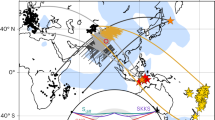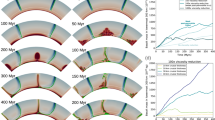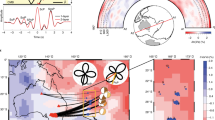Abstract
Surface geophysical data that are related to the process of thermal convection in the Earth's mantle provide constraints on the rheological properties and density structure of the mantle. We show that these convection-related data imply the existence of a region of very high effective viscosity near 2,000 km depth. This inference is obtained using a viscous-flow model based on recent high-resolution seismic models of three-dimensional structure in the mantle. The high-viscosity layer near 2,000 km depth results in a re-organization of flow from short to long horizontal length scales, which agrees with seismic tomographic observations of very long wavelength structures in the deep mantle. The high-viscosity region also strongly suppresses flow-induced deformation and convective mixing in the deep mantle. Here we predict compositional and thermal heterogeneity in this region, using viscous-flow calculations based on the new viscosity profile, together with independent mineral physics data. These maps are consistent with the anti-correlation of anomalies in seismic shear and bulk sound velocity in the deep mantle. The maps also show that mega-plumes in the lower mantle below the central Pacific and Africa are, despite the presence of compositional heterogeneity, buoyant and actively upwelling structures.
This is a preview of subscription content, access via your institution
Access options
Subscribe to this journal
Receive 51 print issues and online access
$199.00 per year
only $3.90 per issue
Buy this article
- Purchase on Springer Link
- Instant access to full article PDF
Prices may be subject to local taxes which are calculated during checkout






Similar content being viewed by others
References
Marsh, J. G. et al. The GEM-T2 gravitational model. J. Geophys. Res. 95, 22043–22071 (1990).
De Mets, C. R., Gordon, R. G., Argus, D. F. & Stein, S. Current plate motions. Geophys. J. Int. 101, 425–478 (1990).
Gwinn, C. R., Herring, T. A. & Shapiro, I. I. Geodesy by radio interferometry: studies of the forced nutations of the Earth. 2. Interpretation. J. Geophys. Res. 91, 4755–4765 (1986).
Mathews, P., Buffet, B. A. & Herring, T. A. What do nutations tell us about the Earth's interior? Eos Trans. AGU 80, (Fall Meeting suppl.) 19 (1999).
Forte, A. M. & Woodward, R. L. Global 3D mantle structure and vertical mass and heat transfer across the mantle from joint inversions of seismic and geodynamic data. J. Geophys. Res. 102, 17981–17994 (1997).
Mooney, W. D., Laske, G. & Masters, T. G. CRUST 5.1: A global crustal model at 5° × 5°. J. Geophys. Res. 103, 727–747 (1998).
Panasyuk, S. V. The effect of compressibility, phase transformations, and assumed density structure on mantle viscosity inferred from Earth's gravity field. PhD dissertation, Massachusetts Institute of Technology (1998).
Forte, A. M. & Perry, H. K. C. Geodynamic evidence for a chemically depleted continental tectosphere. Science 290, 1940–1944 (2000).
Woodward, R. L. et al. in Evolution of the Earth and Planets. Geophys. Monogr. Ser. (eds Takahashi, E., Jeanloz, R. & Rubie, D.) Vol. 74, 89–109 (AGU, Washington, DC, 1993).
Masters, T. G. et al. A shear-velocity model of the mantle. Phil. Trans. R. Soc. Lond. A 354, 1385–1411 (1996).
Li, X.-D. & Romanowicz, B. Global mantle shear-velocity model developed using nonlinear asymptotic coupling theory. J. Geophys. Res. 101, 22245–22272 (1996).
van der Hilst, R. D., Widiyantoro, S. & Engdahl, E. R. Evidence for deep mantle circulation from global tomography. Nature 386, 578–584 (1997).
Grand, S. P., van der Hilst, R. D. & Widiyantoro, S. Global seismic tomography: A snapshot of convection in the Earth. Geol. Soc. Am. Today 7, 1–7 (1997).
van der Hilst, R. D. & Kárason, H. Compositional heterogeneity in the bottom 1000 km of Earth's mantle: Towards a hybrid convection model. Science 283, 1885–1888 (1999).
Tackley, P. J. in The Core-Mantle Boundary Region. Geodyn. Ser. (ed. Gurnis, M. et al.) Vol. 28, 231–253 (AGU, Washington, DC, 1998).
Kellogg, L. H., Hager, B. H. & van der Hilst, R. D. Compositional stratification in the deep mantle. Science 283, 1881–1884 (1999).
Davaille, A. Simultaneous generation of hotspots and superswells by convection in a heterogeneous planetary mantle. Nature 402, 756–760 (1999).
Albarède, F. & van der Hilst, R. D. New mantle convection model may reconcile conflicting evidence. Eos Trans. AGU 80, 535–539 (1999).
Roberston, G. S. & Woodhouse, J. H. Constraints on lower mantle physical properties from seismology and mineral physics. Earth Planet. Sci. Lett. 143, 197–205 (1996).
Su, W. & Dziewonski, A. M. Simultaneous inversion for 3-D variations in shear and bulk velocity in the mantle. Phys. Earth Planet. Inter. 100, 135–156 (1997).
Kennett, B. L. N., Widiyantoro, S. & van der Hilst, R. D. Joint seismic tomography for bulk-sound and shear wavespeed in the Earth's mantle. J. Geophys. Res. 103, 12469–12493 (1998).
Masters, G., Laske, G., Bolton, H. & Dziewonski, A. M. in Earth's Deep Interior: Mineral Physics and Tomography From the Atomic to the Global Scale. Geophys. Monogr. Ser. (eds Karato, S.-I. et al.) Vol. 117, 63–87 (AGU, Washington, DC, 2000).
Ishii, M. & Tromp, J. Normal-mode and free-air gravity constraints on lateral variations in velocity and density of Earth's mantle. Science 285, 1231–1236 (1999).
Dziewonski, A. M. & Anderson, D. L. Preliminary reference Earth model. Phys. Earth Planet. Inter. 25, 297–356 (1981).
Sinelnikov, Y. D., Chen, G. & Liebermann, R. C. Elasticity of CaTiO3-CaSiO3 perovskites. Phys. Chem. Mineral. 25, 515–521 (1998).
Zhang, J. & Weidner, D. J. Thermal equation of state of aluminum-enriched silicate perovskite. Science 284, 782–784 (1999).
McDonough, W. F. & Sun, S.-S. The composition of the Earth. Chem. Geol. 120, 223–253 (1995).
Ekström, G. & Dziewonski, A. M. The unique anisotropy of the Pacific upper mantle. Nature 394, 168–172 (1998).
Karato, S. Importance of anelasticity in the interpretation of seismic tomography. Geophys. Res. Lett. 20, 1623–1626 (1993).
Forte, A. M. & Peltier, W. R. The kinematics and dynamics of poloidal-toroidal coupling in mantle flow: The importance of surface plates and lateral viscosity variations. Adv. Geophys. 36, 1–119 (1994).
Karato, S.-I. & Li, P. Diffusion creep in perovskite: Implications for the rheology of the lower mantle. Science 255, 1238–1240 (1992).
Constable, S. C., Parker, R. L. & Constable, C. G. Occam's inversion: A practical algorithm for generating smooth models from electromagnetic sounding data. Geophysics 52, 289–300 (1987).
King, S. & Masters, T. G. An inversion for the radial viscosity structure using seismic tomography. Geophys. Res. Lett. 19, 1551–1554 (1992).
Mitrovica, J. X. & Forte, A. M. The radial profile of mantle viscosity: Results from the joint inversion of convection and post-glacial rebound observables. J. Geophys. Res. 102, 2751–2769 (1997).
Forte, A. M. in Earth's Deep Interior: Mineral Physics and Tomography From the Atomic to the Global Scale. Geophys. Monogr. Ser. (eds Karato, S.-I. et al.) Vol. 117, 3–36 (AGU, Washington, DC, 2000).
Durek, J. & Ekström, G. A radial model of anelasticity consistent with long-period surface-wave attenuation. Bull. Seismol. Soc. Am. 86, 144–158 (1996).
Karato, S.-I. A dislocation model of seismic wave attenuation and micro-creep in the Earth. Pure Appl. Geophys. 153, 239–256 (1998).
Hofmann, A. W. The gabbro-harzburgite connection in OIB sources. Eos Trans. AGU 80 (Fall Meeting suppl.) 1182–1183 (1999).
Ottino, J. M. The Kinematics of Mixing: Stretching, Chaos, and Transport Ch. 2 & 4 (Cambridge Univ. Press, Cambridge, 1989).
Kellogg, J. B. & O'Connell, R. J. The effects of toroidal motion and layered viscosity on mixing in three dimensions. Eos Trans. AGU 80 (Fall Meeting suppl.) 949 (1999).
Hager, B. H. Subducted slabs and the geoid: Constraints on mantle rheology and flow. J. Geophys. Res. 89, 6003–6015 (1984).
Forte, A. M. & Peltier, W. R. Plate tectonics and aspherical Earth structure: The importance of poloidal-toroidal coupling. J. Geophys. Res. 92, 3645–3679 (1987).
Ricard, Y. & Vigny, C. Mantle dynamics with induced plate tectonics. J. Geophys. Res. 94, 17543–17559 (1989).
Gurnis, M. & Davies, G. F. The effect of depth-dependent viscosity on convective mixing of the mantle and the possible survival of primitive mantle. Geophys. Res. Lett. 13, 541–544 (1986).
Manga, M. Mixing of heterogeneities in the mantle—Effects of viscosity differences. Geophys. Res. Lett. 23, 403–406 (1996).
van Keken, P. & Ballentine, C. J. Whole-mantle versus layered mantle convection and the role of a high-viscosity lower mantle in terrestrial volatile evolution. Earth Planet. Sci. Lett. 156, 19–32 (1998).
Bunge, H.-P. & Richards, M. A. The origin of large-scale structure in mantle convection: Effects of plate motions and viscosity stratification. Geophys. Res. Lett. 23, 2987–2990 (1996).
Ritsema, J., van Heijst, H. J. & Woodhouse, J. H. Complex shear velocity structure imaged beneath Africa and Iceland. Science 286, 1925–1928 (1999).
Gurnis, M., Mitrovica, J. X., Ritsema, J. & van Heijst, H. J. Constraining mantle density structure using geological evidence of surface uplift rates: The case of the African superplume. Geochem. Geophys. Geosystems. [online] 1 (2000).
Jackson, I. Elasticity, composition and temperature of the Earth's lower mantle: A reappraisal. Geophys. J. Int. 134, 291–311 (1998).
Stacey, F. D. Thermoelasticity of a mineral composite and a reconsideration of lower mantle properties. Phys. Earth Planet. Inter. 106, 219–236 (1998).
Jackson, I., Paterson, M. S. & Fitzgerald, J. D. Seismic wave attenuation in Åheim dunite: An experimental study. Geophys. J. Int. 108, 517–534 (1992).
Zerr, A., Diegler, A. & Boehler, R. Solidus of Earth's deep mantle. Science 281, 243–246 (1998).
Stacey, F. D. Theory of thermal and elastic properties of the lower mantle and core. Phys. Earth Planet. Inter. 89, 219–245 (1995).
Acknowledgements
We thank I. Jackson for a review, for suggestions used in the Methods section, and for the detailed check of the derivatives in Table 1. A.M.F. also thanks A. Davaille for many helpful discussions. We acknowledge support from NSERC, the Canada Foundation for Innovation, the Ontario Innovation Trust, and the Canadian Institute for Advanced Research—Earth Systems Evolution Program.
Author information
Authors and Affiliations
Corresponding author
Supplementary information
Rights and permissions
About this article
Cite this article
Forte, A., Mitrovica, J. Deep-mantle high-viscosity flow and thermochemical structure inferred from seismic and geodynamic data. Nature 410, 1049–1056 (2001). https://doi.org/10.1038/35074000
Received:
Accepted:
Issue Date:
DOI: https://doi.org/10.1038/35074000
This article is cited by
-
Observed and Calculated M2 Tidal Gravimetric Factors at 15 Stations in the Mainland of China
Pure and Applied Geophysics (2021)
-
Multi-physics adjoint modeling of Earth structure: combining gravimetric, seismic, and geodynamic inversions
GEM - International Journal on Geomathematics (2020)
-
The role of diffusion-driven pure climb creep on the rheology of bridgmanite under lower mantle conditions
Scientific Reports (2019)
-
Tidal tomography constrains Earth’s deep-mantle buoyancy
Nature (2017)
-
Density structure of Earth’s lowermost mantle from Stoneley mode splitting observations
Nature Communications (2017)
Comments
By submitting a comment you agree to abide by our Terms and Community Guidelines. If you find something abusive or that does not comply with our terms or guidelines please flag it as inappropriate.








